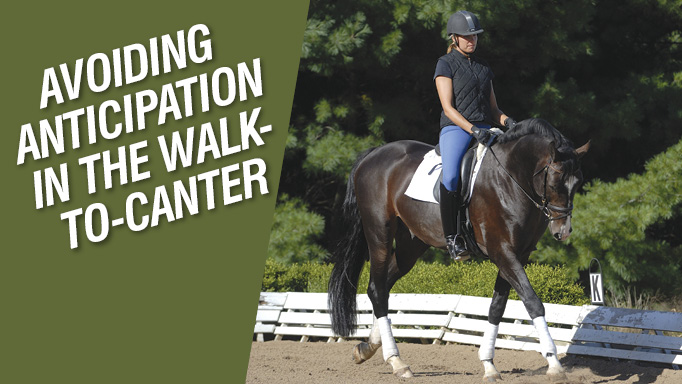Karen Pavicic was a member of Canada’s 2007 Pan Am Games Dressage Team as the travelling reserve with her horse, Lionheart. A Level III dressage coach, she has trained a number of horses and riders to success at the FEI levels. Currently long-listed for the Canadian Team with Don Daiquiri and London, Karen has declared for the 2012 Olympic Team with Don Daiquiri. She trains out of Centre Line Stables in Richmond, BC.
THE WALK – DOUBLE POINTS, DOUBLE THE IMPORTANCE
The free or extended walk is a coefficient movement in every test from training level to the Grand Prix Special, which means that whatever mark the judge gives is double-weight. In most of the tests from training through fourth level, the transition from the free or extended walk to medium or collected walk is included in that coefficient movement. Like the halts on centreline, the walk is a movement where good technical execution almost guarantees a good mark, regardless of the horse’s athleticism. Even a horse that doesn’t have a huge over-track can consistently get sevens if the walk and transitions are performed well.
Anticipation is not necessarily a bad thing; hotter horses tend to anticipate, but they often go on to become top horses if the rider is able to use that energy in the right direction. Lazier horses can also be made more sensitive to the aids by using anticipation.
In tests, horses quickly learn that the walk is usually followed by canter – the most exciting of the three gaits – which can cause the horse to become tense in expectation. The rider, particularly if less experienced, is also likely to become nervous. When anticipation results in the horse becoming tense or breaking into a jog in a test, the damage to the score is significant. The walk mark goes down, and the mark for the transition to trot or canter almost always suffers, too.
PRACTISE, PRACTISE, PRACTISE
I frequently work on the walk in the cool-down at the end of my ride, but I also often practise in the middle of the ride. You can work on going from free to medium walk anywhere in the ring, but it’s useful to ride diagonals, since that is where the free walk is ridden in tests.
Let the horse out in a forward and relaxed walk, then pick up the reins and walk on the contact. Repeat. You can vary where you pick up the reins – partway through a diagonal, or at the end. The goal is to feel that the horse is as relaxed after the reins are picked up as he was in the free walk.
I tell my students to imagine they are in the free walk at the end of the test as they leave the ring. The free walk in the test should feel as relaxed as when the horse knows he is finished working. When they pick up the reins, I remind my students to stay relaxed and to think about the ‘wet blanket’ concept of having their legs draped on the horse. One of the most common mistakes riders make when they feel the horse becoming tense is to take their legs off. Then, when they ask the horse for the upward transition to canter, the leg comes suddenly out of nowhere and the horse over-reacts, sometimes explosively. The more the rider practises picking up the reins and then not doing an upward transition, the more likely the horse is to remain relaxed, which in turn makes it easier to keep the legs on the horse’s sides.
Riders tend to address problems with the upward transition to canter after the walk in one of two ways: they either over-school it, which creates more tension and makes the horse anticipate even more, or they don’t practise it at all. The most important thing to remember is not to ride the transition to canter if the horse begins to anticipate. Instead, pick up the reins and ride a ten-meter circle in medium walk before doing the transition. Just that one circle is usually enough to teach the horse to wait for the aids for the transition.
There is no magic trick to correcting anticipation in the walk, only patience and practise.

